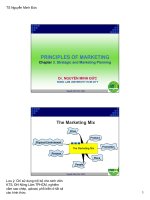Lecture Principles of Marketing - Chapter 7: Customer-driven Marketing strategy
Bạn đang xem bản rút gọn của tài liệu. Xem và tải ngay bản đầy đủ của tài liệu tại đây (1.62 MB, 35 trang )
i t ’s good and
good for you
Chapter Seven
Customer-Driven Marketing
Strategy:
Creating Value for Target
Customers
Copyright © 2012Pearson
2012 PearsonEducation,
Education,Inc.
Inc.
Publishing as Prentice Hall
7- 1
Customer-Driven Marketing Strategy:
Creating Value for Target Customers
•
•
•
•
•
Topic Outline
Customer-Driven Marketing Strategy
Market Segmentation
Market Targeting
Differentiation and Positioning
Copyright © 2012 Pearson Education, Inc.
Publishing as Prentice Hall
7- 2
Market Segmentation
Market segmentation
Dividing a market into smaller segments
with distinct needs, characteristics, or
behavior that might require separate
marketing strategies or mixes.
Copyright © 2012 Pearson Education, Inc.
Publishing as Prentice Hall
7- 3
Market Segmentation
Copyright © 2012 Pearson Education, Inc.
Publishing as Prentice Hall
7- 4
Market Segmentation
•
•
•
•
Segmenting consumer markets
Segmenting business markets
Segmenting international markets
Requirements for effective segmentation
Copyright © 2012 Pearson Education, Inc.
Publishing as Prentice Hall
7- 5
Market Segmentation
•
Segmenting Consumer Markets
Copyright © 2012 Pearson Education, Inc.
Publishing as Prentice Hall
7- 6
Market Segmentation
•
•
Segmenting Consumer Markets
Geographic segmentation divides the
market into different geographical units
such as nations, regions, states,
counties, or cities
Copyright © 2012 Pearson Education, Inc.
Publishing as Prentice Hall
7- 7
Market Segmentation
•
Segmenting Consumer Markets
Demographic
segmentation divides the
market into groups based on
variables such as age,
gender, family size, family
life cycle, income,
occupation, education,
religion, race, generation,
and nationality
Copyright © 2012 Pearson Education, Inc.
Publishing as Prentice Hall
7- 8
Market Segmentation
Age and life-cycle stage segmentation
is the process of offering different
products or using different marketing
approaches for different age and life-cycle
groups
Gender segmentation divides the
market based on sex (male or female)
Copyright © 2012 Pearson Education, Inc.
Publishing as Prentice Hall
7- 9
Market Segmentation
•
Segmenting Consumer Markets
Income segmentation
divides the market into
affluent, middle-income or
low-income consumers
Psychographic
segmentation divides
buyers into different groups
based on social class,
lifestyle, or personality traits
Copyright © 2012 Pearson Education, Inc.
Publishing as Prentice Hall
7- 10
Market Segmentation
•
Segmenting Consumer Markets
Behavioral segmentation
divides buyers into groups
based on their knowledge,
attitudes, uses, or
responses to a product
•
Occasions
•
Benefits sought
•
User status
•
Usage rate
•
Loyalty status
Copyright © 2012 Pearson Education, Inc.
Publishing as Prentice Hall
7- 11
Market Segmentation
•
Using Multiple Segmentation Bases
Multiple segmentation is used to identify
smaller, better-defined target groups
•
Copyright © 2012 Pearson Education, Inc.
Publishing as Prentice Hall
7- 12
Market Segmentation
•
Using Multiple Segmentation Bases
PRIZM NE classifies every American
household into 66 unique segments
organized into 14 different social
groups.
•
These groups segment people and
locations into marketable groups of
like-minded consumers that exhibit
unique characteristics and buying
behavior based on a host of
demographic factors
Copyright © 2012 Pearson Education, Inc.
Publishing as Prentice Hall
7- 13
Market Segmentation
•
Segmenting International markets
Copyright © 2012 Pearson Education, Inc.
Publishing as Prentice Hall
7- 14
Market Segmentation
•
Segmenting International Markets
Intermarket segmentation divides
consumers into groups with similar needs
and buying behaviors even though they
are located in different countries
Copyright © 2012 Pearson Education, Inc.
Publishing as Prentice Hall
7- 15
Market Segmentation
•
Requirements for Effective Segmentation
To be useful, market segments must be:
Copyright © 2012 Pearson Education, Inc.
Publishing as Prentice Hall
7- 16
Market Targeting
Selecting Target Market Segments
Target market consists of a set of buyers
who share common needs or
characteristics that the company decides
to serve
•
Copyright © 2012 Pearson Education, Inc.
Publishing as Prentice Hall
7- 17
Market Targeting
Evaluating Market Segments
Segment size and growth
•
.
Segment
structural attractiveness
Company objectives and resources
•
•
•
•
Copyright © 2012 Pearson Education, Inc.
Publishing as Prentice Hall
7- 18
Market Targeting
•
Target Marketing Strategies
Undifferentiated marketing targets the
whole market with one offer
–
–
Mass marketing
Focuses on common needs rather than
what’s different
Copyright © 2012 Pearson Education, Inc.
Publishing as Prentice Hall
7- 19
Market Targeting
•
Target Marketing Strategies
Differentiated marketing targets several
different market segments and designs
separate offers for each
•
Goal is to achieve higher sales and
stronger position
•
More expensive than undifferentiated
marketing
Copyright © 2012 Pearson Education, Inc.
Publishing as Prentice Hall
7- 20
Market Targeting
•
•
•
•
•
Target Market Strategies
Concentrated marketing
targets a small share of a
large market
Limited company
resources
Knowledge of the market
More effective and
efficient
Copyright © 2012 Pearson Education, Inc.
Publishing as Prentice Hall
7- 21
Marketing Targeting
•
Target Market Strategies
Micromarketing is the practice of
tailoring products and marketing
programs to suit the tastes of specific
individuals and locations
•
Local marketing
•
Individual marketing
Copyright © 2012 Pearson Education, Inc.
Publishing as Prentice Hall
7- 22
Market Targeting
•
Target Market Strategies
Local marketing involves tailoring
brands and promotion to the needs and
wants of local customer groups
•
Cities
•
Neighborhoods
•
Stores
Copyright © 2012 Pearson Education, Inc.
Publishing as Prentice Hall
7- 23
Market Targeting
Target Market Strategies
•
Individual marketing involves
tailoring products and marketing
programs to the needs and
preferences of individual
customers
•
Also known as:
–
–
–
One-to-one marketing
Mass customization
Markets-of-one marketing
Copyright © 2012 Pearson Education, Inc.
Publishing as Prentice Hall
7- 24
Market Targeting
Choosing a Target Market
Depends on:
•
Company resources
•
Product variability
•
Product life-cycle stage
•
Market variability
•
Competitor’s marketing strategies
•
Copyright © 2012 Pearson Education, Inc.
Publishing as Prentice Hall
7- 25









